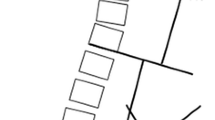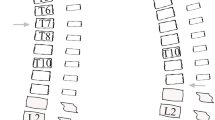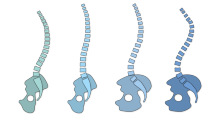Abstract
Purpose
In our study, we assessed the condition of the lumbar laminae defect of L5, other than the defect of spina bifida, in a group of different ages with lower lumbar disc herniation (LDH). We hypothesize that the laminae defect of L5 may be a radiographic feature in young patients with lower LDH.
Methods
We analyzed the features of the laminae of L5 from the anteroposterior X-rays of the lumbosacral spine in 342 patients suffering from lower LDH. The patients were divided into three groups depending on age: age <45 (group A), 45 ≤ age ≤ 59 (group B) and age>59 (group C). The width of the unilateral laminae of L5 was measured by drawing a line named “a” from the upper margin to the lower margin. Then the line “a” was extended downward to the bottom of the laminae interval space to perform a new line named “b”. We assessed the condition of the laminae defect of L5 using the ratio “a/b” in each group.
Results
The average ratio “a/b” in each group was: 0.47 ± 0.06 in group A, 0.51 ± 0.06 in group B, and 0.52 ± 0.06 in group C. The average ratio “a/b” of group A was significantly smaller than group B and group C (P<0.05). However, there was no statistical difference of the average ratio “a/b” between group B and group C (P>0.05).
Conclusions
Laminae defects of L5 may be a congenitally potential risk factor leading to lower LDH in the young and this radiographic clue could be used for the diagnosis of symptomatic lower LDH patients. For asymptomatic people who encounter this radiographic feature, preventive advice could be provided.


Similar content being viewed by others
Abbreviations
- LDH:
-
Lumbar disc herniation
References
Zhang Q, Qian J, Zhu Y (2015) Meta-analysis on microdiscectomy and sequestrectomy for lumbar disc herniation. J Investig Surg 28(4):225–229
Battié MC, Videman T, Parent E (2004) Lumbar disc degeneration: epidemiology and genetic influences. Spine 29(23):2679–2690
Manninen P, Riihimäk H, Heliövaara M (1995) Incidence and risk factors of low-back pain in middle-aged farmers. Occup Med (Oxford, England) 45(3):141–146
Riihimäki H, Wickström G, Hänninen K, Luopajärvi T (1989) Predictors of sciatic pain among concrete reinforcement workers and house painters—a five-year follow-up. Scand J Work Environ Health 15(6):415–423
Brailsford JF (1928) Deformities of the lumbosacral region of the spine. Br J Surg 16:562–627
Farfan HF, Sullivan JD (1967) The relation of facet orientation to intervertebral disc failure. Can J Surg 10(2):179–185
Ishihara H, Matsui H, Osada R, Ohshima H, Tsuji H (1997) Facet joint asymmetry as a radiologic feature of lumbar intervertebral disc herniation in children and adolescents. Spine 22(17):2001–2004
Saluja PG (1988) The incidence of spina bifida occulta in a historic and a modern London population. J Anat 158:91–93
Avrahami E, Frishman E, Fridman Z, Azor M (1994) Spina bifida occulta of S1 is not an innocent finding. Spine 19(1):12–15
Degreif J, Wenda K, Runkel M, Ritter G (1994) Rotational stability of the thoracolumbar spine after interlaminar ultrasound window, hemilaminectomy and laminectomy. A comparative experimental study. Unfallchirurg 97(5):250–255
Heuer F, Schmidt H, Wilke HJ (2008) Stepwise reduction of functional spinal structures increase disc bulge and surface strains. J Biomech 41(9):1953–1960. https://doi.org/10.1016/j.jbiomech.2008.03
Acknowledgements
Thanks to Elizabeth Ekpo for grammatical corrections.
Author information
Authors and Affiliations
Corresponding author
Ethics declarations
Conflict of interest
The authors declare that they have no conflict of interest.
Ethical approval
This article does not concern studies involving human participants or animals performed by any of the authors.
Informed consent
For this type of study formal consent is not required.
Additional information
Shiwu Tao and Lin Jin contributed to the work equally and should be regarded as co-first authors.
Rights and permissions
About this article
Cite this article
Tao, S., Jin, L., Hou, Z. et al. A New radiographic feature of lower lumbar disc herniation in young patients. International Orthopaedics (SICOT) 42, 583–586 (2018). https://doi.org/10.1007/s00264-017-3723-8
Received:
Accepted:
Published:
Issue Date:
DOI: https://doi.org/10.1007/s00264-017-3723-8




